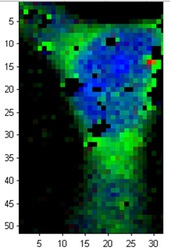Highlight
Raman-active gold nanoparticles as beacons in breast cancer cells
Achievement/Results
Nanoparticles can be utilized to overcome the undesired side effects that occur with current chemotherapeutic treatments by delivering the drug directly to the tumor site. Raman-active gold nanoparticles (RA-AuNPs) can be used as bio-tags to simultaneously deliver and track the nanosystem throughout cervical cancer cells by exploiting surface-enhanced Raman spectroscopic (SERS) effects. In this project, a gold nanosphere core along with a SERS reporter (2-cyano-2-hexanoic acid) was used to study this effect. The SERS reporter behaves as a beacon by enhancing the Raman signal while the targeting peptides will specifically target breast cancer cells. The use of Raman microspectroscopy allows for mapping of cancerous cells. When coupled with vertex component analysis this allows the production of pseudo color maps based on spectral dissimilarities. This process will allow us to detect and monitor RA-AuNPs capable of delivering chemotherapeutic agents.
Address Goals
The National Cancer Institute has recognized nanotechnology as one of the promising technologies in the fight against cancer. Research in the field of cancer nanotechnology is highly interdisciplinary and offers new approaches in the diagnosis and treatment of cancer. One of the biggest challenges faced in cancer therapy is the lack of understanding on the successful delivery of chemotherapeutics in the cancer area. Nanoparticles can be synthesized to have the ability to encapsulate chemotherapeutic drugs which will minimize undesirable side effects. Along with this, reporters can be attached to nanoparticles that will enable monitoring of these within the body. This simultaneous delivery of drug along with the ability to monitor their delivery has had enormous benefits in the fight against cancer. This will allow for better monitoring of the effectiveness of drug delivery along with better treatment outcome for cancer patients resulting in improved survival.






